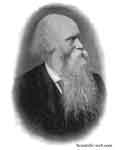Ralph Copeland (September 3, 1837 – October 27, 1905) was an English astronomer and the third Astronomer Royal for Scotland.
Copeland was born at Moorside Farm, near Woodplumpton in Lancashire, England and attended Kirkham Grammar School. He spent 5 years in Australia where he discovered his interest in astronomy. He returned in 1858 to pursue a career in engineering.
Eager to pursue his astronomical interests, Copeland built a small observatory, gave up engineering, and then travelled to Germany to study astronomy at the University of Göttingen. When he returned to England, as a patron of Lord Rosse, Copeland brought back German methods of astronomy. Later he appointed many German astronomers as assistants, such as Oswald Lohse.
Copeland then worked at the Dun Echt Observatory owned by the 26th Earl of Crawford. Copeland was a frequent traveler on worldwide expeditions and observed the 1874 and 1882 transitions of Venus from Mauritius and Jamaica, respectively, and undertook other astronomical observations from Greenland.
On January 29, 1889, Copeland became Astronomer Royal for Scotland, whereupon he first worked in Observatory House, Edinburgh. He was tasked to select a site for a new observatory, eventually choosing Blackford Hill, Edinburgh. Lord Crawford, his former benefactor, donated the astronomical collection from Dun Echt to the new site, which was opened in 1896.
Copeland served as Astronomer Royal until his death in 1905. He was buried in Morningside Cemetery in Edinburgh.
Copeland discovered thirty-five NGC objects, most of them with Lord Rosse's 72" reflector. Planetary nebulae were found by visual spectroscopy at Dun Echt and during an Andes expedition. Seven of the galaxies in the constellation Leo form the famous "Copeland Septet": NGC 3745, 3746, 3748, 3750, 3751, 3753, and 3754.
Copeland was married twice and had six children. He was also fluent in French, German and Persian.
Legacy
Mount Copeland, in the Monashee Mountains to the northwest of Revelstoke, British Columbia, was named for him in 1939, as was Copeland Ridge (which Mount Copeland is the summit of) and nearby Copeland Creek.[1][2][3] Mount Copeland is the site of the highest recorded snowfall in North America in one season (July 1, 1971-June 30, 1972).[4]
References
1. ^ "Copeland, Mount". BC Geographical Names Information System. http://archive.ilmb.gov.bc.ca/bcgn-bin/bcg10?name=12338.
2. ^ "Copeland Ridge". BC Geographical Names Information System. http://archive.ilmb.gov.bc.ca/bcgn-bin/bcg10?name=12341.
3. ^ "Copeland Creek". BC Geographical Names Information System. http://archive.ilmb.gov.bc.ca/bcgn-bin/bcg10?name=12337.
4. ^ Greatest Snowfalls in North America (reference), teachervision.com
Further reading
* Dreyer, J. L. E. (1906). "Ralph Copeland". Monthly Notices of the Royal Astronomical Society 66: 164 – 174. http://adsabs.harvard.edu/abs/1906MNRAS..66..164..
Retrieved from "http://en.wikipedia.org/"
All text is available under the terms of the GNU Free Documentation License


